
.jpg)
The Crazy Horse Memorial honors the North American Indian and is so much more than a mountain carving.
Crazy Horse was born on Rapid Creek in the Black Hills of South Dakota in about 1842. While at Fort Robinson, Nebraska, under a flag of truce, he was stabbed in the back by an American Soldier and died September 6, 1877 (about age 35(?))
Crazy horse defended his people and their way of life in the only manner he knew, but only after he saw the Treat of 1868 broken. The Treaty, signed by the President of the United States, said, in effect: As long as rivers run and grass grows and trees bear leaves, Paha Sapa - the Black Hills of Dakota - will forever be the sacred land of the Sioux Indians. Only after he saw his leader, Conquering Bear, exterminated by treachery. Only after he saw the failure of the government agents to bring required treaty guarantees, such as meat, clothing, tents and necessities for existence which they were to receive for having given up their lands and gone to live on the reservations. Only after he saw his peoples' lives and their way of life ravaged and destroyed. Crazy Horse was never known to have signed a treaty or tuched the pen.
Crazy Horse, as far as the scale model is concerned, is to be carved not so much as a likeness, but more as a memorial to the spirit of Crazy Horse - to his people.
With his left hand thrown out pointing in answer to the derisive question asked by a white man, "Where are your lands now?" he replied, "My lands are where my dead lie buried."
Sculptor Korczak Ziolkowski was a completely self-taught sculptor. He never took a formal lesson in art, sculpture, architecture or engineering. He arrived in the Black Hills in 1939 to help Gutzon Borglum on Mount Rushmore.
Almost 70 years ago, Lakota (Sioux) Chief Henry Standing Bear asked Korczak to create a monument of Crazy Horse in their sacred Black Hills. Standing Bear read reports of Korczak's artistic achievements and invited him to create a mountain tribute. Chief Standing Bear wrote "My fellow chiefs and I would like the white man to know the red man has great heroes, too."
Following the completion of Mount Rushmore, Korczak served his country in Europe in World War II. After the war he returned to the Black hills to tackle the mountain.
He started with chisels and hammers, doing back breaking work by hand. The first blast on the mountain was June 3, 1948. Korczak's wife, Ruth, was by his side every step of the way. She was 18 years younger than he, but embraced his dream. She took care of 10 children, five girls and five boys, the visitors, a dairy, a sawmill and Korczak. Following his death at age 74 in 1982, Ruth took on Korczak's monumental task of making the dream come true. She is supported by an enthusiastic staff, business-savvy board of birectors of the nonprofit foundation and a growing international group of members of the Grass Roots Club. Seven of their children help to continue and expand on their father's work. The other three children live within fiv emiles of the Memorial. Ruth still lives in the home Korczak built in 1947 and works 7 days a week keeping all aspects of the Memorial going. At age 82 her love for her work keeps her happy and she is grateful to begin each new day.
The Monument is funded by visitor fees and generous donations. No Federal money has ever been accepted and will never be accepted!
Workers hope to have the head of the horse completed within the next seven years, and the entire sculpture, in the round, should be complete within the next 40 years!


.jpg)
.jpg)
.jpg)
.jpg)
.jpg)
.jpg)
.jpg)
.jpg)
.jpg)
.jpg)




.jpg)
.jpg)
.jpg)
.jpg)























.jpg)
.jpg)
.jpg)
.jpg)

.jpg)
.jpg)